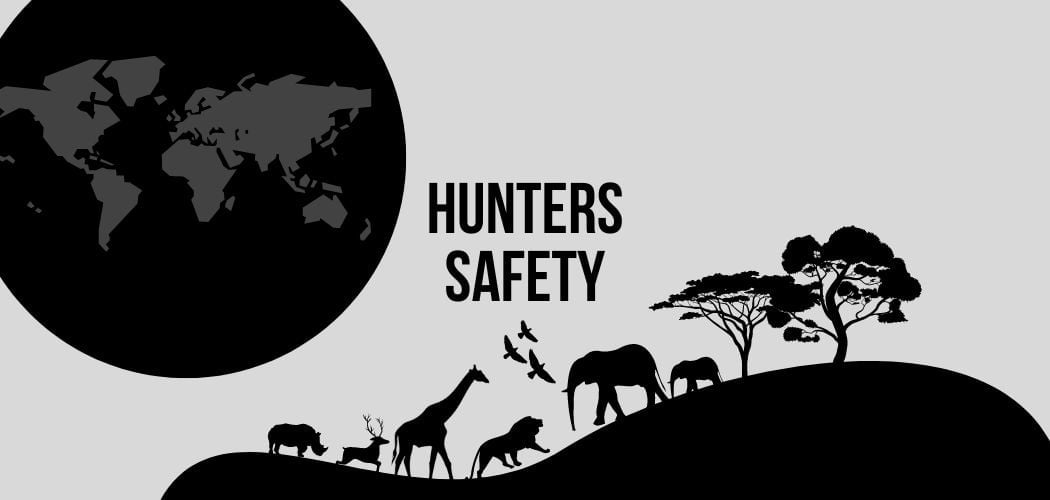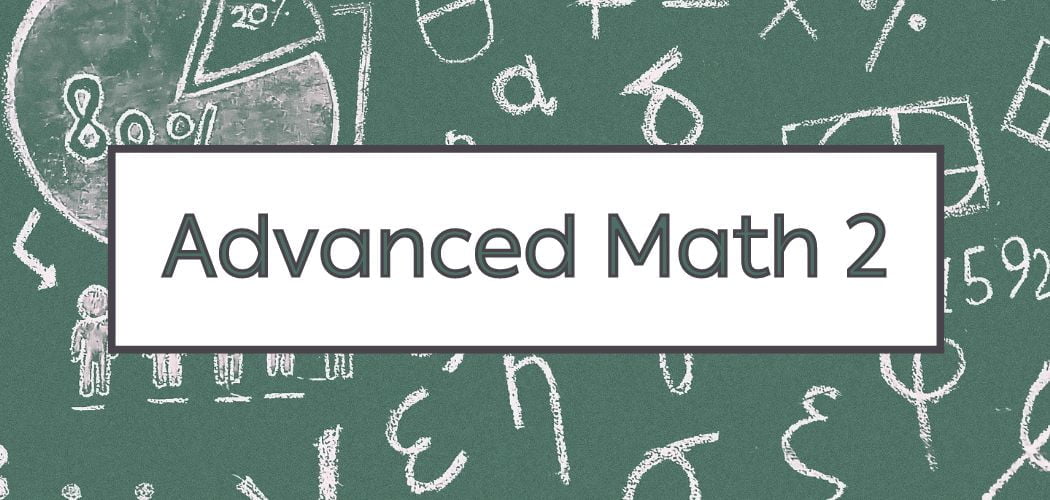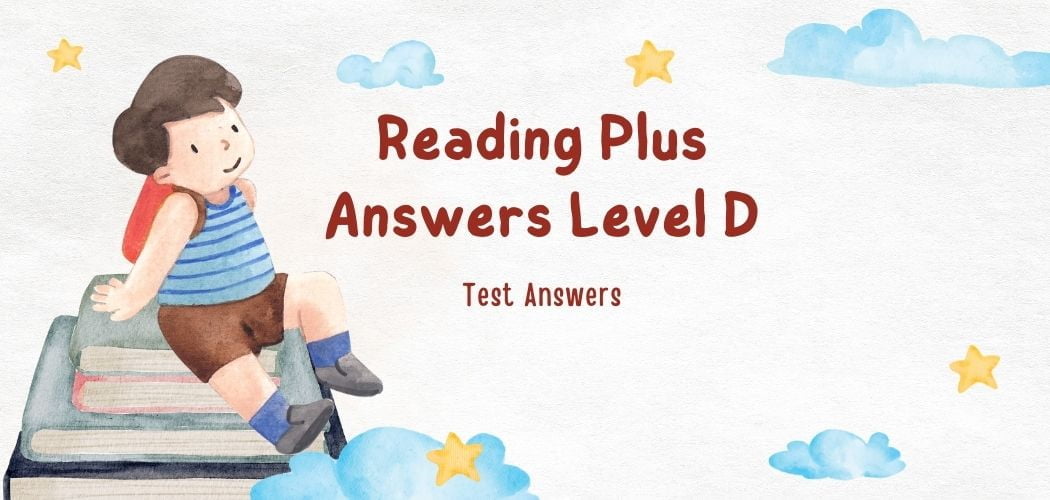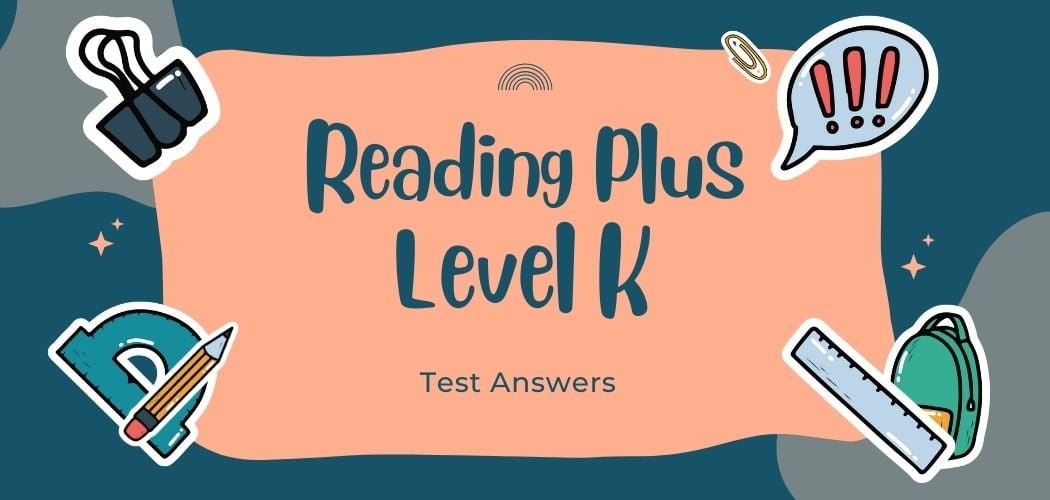The GED is an important test that requires preparation. Since it is a computer-based exam, the test questions are scrambled to protect its integrity. We recommend reading the following articles to know more about the exam and learn key strategies that’ll help you make big improvements during the actual tests.
This is Part-3 of our free GED reviewer for Social Science. Topics included in this review are material history, geography, economics, and civics. The exam is designed to test your knowledge and understanding of social science.
GED reviewer for Social Science
Refer from the graph below and answer the question that follows.

Question 1. Based on the information in the graph, which of the following proposals might best improve the voting rate?
A. Organize buses to help people get to voting places.
B. Reschedule Election Day to a weekend so that people who are busy at work and at school can be available to vote.✅
C. Provide more interesting candidates that inspire people to vote.
D. Distribute umbrellas to all households to encourage people to vote on rainy election days.
Read the passage below and answer the following question.
The Sixth Amendment of the U.S. Constitution states, “In all criminal prosecutions, the accused shall enjoy the right to a speedy and public trial, by an impartial jury of the State and district wherein the crime shall have been committed, which district shall have been previously ascertained by law, and to be informed of the nature and cause of the accusation; to be confronted with the witnesses against him; to have compulsory process for obtaining witnesses in his favor, and to have the Assistance of Counsel for his defense.”
Question 2. Which of the following instances is NOT protected by the Sixth Amendment?
A. A trial is moved to another area because no jurors could be found who had not heard of the crime and had an opinion about who committed it
B. A lawyer informs an accused person of her charges
C. A person accused of drug trafficking hires a lawyer to defend him.
D. A person accused of a crime silently prays before his trial begins.✅
Read the passage below and answer the following question.
The First Amendment to the U.S. Constitution states the following: “Congress shall make no law respecting an establishment of religion, or prohibiting the free exercise thereof, or abridging the freedom of speech, or of the press; or the right of the people peaceably to assemble, and to petition the Government for a redress of grievances.”
Question 3. Which of the following situations is NOT protected by the First Amendment?
A. a police officer reads a suspect his rights✅
B. a New York Times editorial criticizes the government’s foreign policy
C. a New York Times editorial criticizes the government’s foreign policy
D. a group meets in a chapel to worship
For questions 4 and 5 refer to the passage below.
“Today, education is perhaps the most important function of state and local governments. Compulsory school attendance laws and the great expenditures for education both demonstrate our recognition of the importance of education to our democratic society. It is required in the performance of our most basic public responsibilities, even service in the armed forces. It is the very foundation of good citizenship. Today, it is a principal instrument in awakening the child to cultural values, preparing him for later professional training, and in helping him to adjust normally to his environment. These days, it is doubtful that any child may reasonably be expected to succeed in life if he is denied the opportunity of an education. Such an opportunity, where the state has undertaken to provide it, is a right that must be made available to all on equal terms.
We come then to the question presented: Does segregation of children in public schools solely on the basis of race, even though the physical facilities and other ‘tangible’ factors may be equal, deprive the children of the minority group of equal educational opportunities? We believe that it does.” —U.S. Supreme Court Chief Justice Earl Warren in a 1954 decision that ruled that separate schools for blacks and whites were unconstitutional. Source: Legal Information Institute, Cornell Law School, Brown v. Board of Education of Topeka.
Question 4. According to the passage, how might the court define “equal educational opportunity”?
A. schools that only admit students based on sex
B. schools that separate minority students to give them a better chance
C. schools of the same quality and welcome all students regardless of race✅
D. schools with the same quality of facilities and materials
Question 5. Which of the following is NOT a purpose of education as expressed in the passage?
A. to explain the government’s education budget✅
B. to produce good citizens
C. to prepare those who might serve the country as soldiers
D. to expose children to values
For questions 6-8, refer to the map provided below.

Question 6. Which of the following conclusions can you make from the information in the map?
A. Increasing numbers of Americans consider themselves political independents.
B. There were distinct regional differences in voting patterns.✅
C. You can not make any predictions about voting patterns based on region.
D. Women are more likely than men to vote for the Democratic Party
Question 7. Which of the following is NOT a true statement?
A. If Kerry had won Florida’s electoral votes, he would have become president.
B. Bush did not appeal to most voters on the west coast.
C. If Kerry had won New Hampshire’s electoral votes, he would have become president.
D. George W. Bush won a larger number of states.✅
Question 8. Based on the information on the map, which of the following might be true of Kerry’s campaign strategy?
A. Kerry campaigned vigorously in George W. Bush’s home state of Texas.
B. Based on the information on the map, which of the following might be true of Kerry’s campaign strategy?✅
C. It focused on winning most of the states with small populations.
D. It focused on winning the states in the southeast.
For questions 9 and 10 refer to the form provided below.
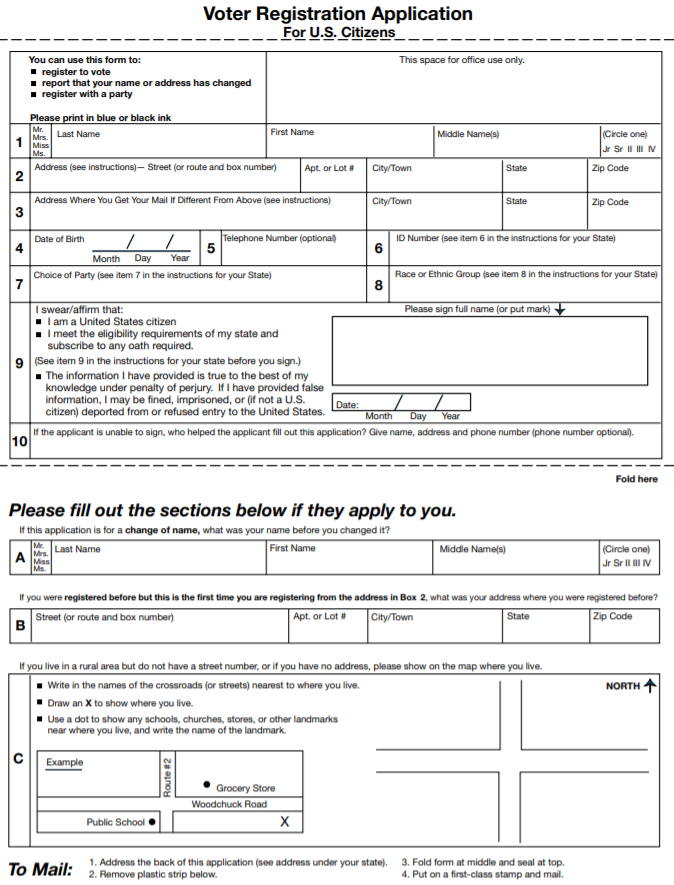
Question 9. Which of the following expresses a fact rather than an opinion?
A. The voting age should be changed from 18 to 21 years of age.
B. The government should allow noncitizens to vote.
C. States have different requirements about who is eligible to vote.✅
D. Every state should institute a “voter-motor” program in which people can register to vote at the same time that they are registering their motor vehicle.
Question 10. Which of the following is NOT a purpose of this form?
A. registering with a political party
B. indicating that you have moved and will be voting in another district
C. notifying the government that you have changed your name
D. applying for U.S. citizenship✅
Refer to the passage below and answer the question that follows.
German printer Johannes Gutenberg is often credited with the invention of the first printing press to use movable type. He used handset type to print the Gutenberg Bible in 1455. Although his invention greatly influenced printing in Europe, similar technologies were used earlier in China and Korea. Chinese printers used movable block prints and type made of clay as early as 1040, and Korean printers invented movable copper types about 1392.
Question 11. What is the purpose of the paragraph?
A. to connect the early advances in printing with today’s technological advances
B. to give credit to Gutenberg for the first movable-type printing press
C. to show how Gutenberg’s invention made printed materials more widely available
D. to show that technological advances can develop in different geographical areas over periods of time✅
For questions 12 and 13 refer to the engraving provided below
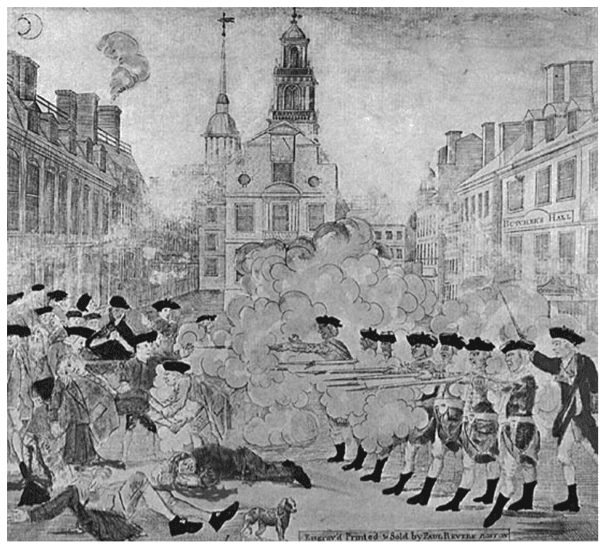
Question 12. What can you infer was Revere’s purpose in creating and selling the engraving?
A. fuel the revolutionary cause✅
B. calm the rebellious spirit of Boston citizens
C. create support for the British empire
D. make a large profit for himself
Question 13. Which of the following messages did Paul Revere most likely want to convey in his engraving?
A. British troops used only necessary force in dealing with the rioting crowd.
B. Americans should willingly pay British taxes on imports of glass, paper, paint, and tea.
C. British troops savagely killed unarmed citizens✅
D. The British troops were defending themselves against rowdy gangs of colonists.
Read the passage below and answer the question that follows.
When European settlers arrived on the North American continent at the end of the fifteenth century, they encountered diverse Native American cultures—as many as 900,000 inhabitants with over 300 different languages. These people, whose ancestors crossed the land bridge from Asia in what may be considered the first North American immigration, were virtually destroyed by the subsequent immigration that created the United States. This tragedy is the direct result of treaties, written and broken by foreign governments, warfare, and of forced assimilation. Source: The Library of Congress, American Memory
Question 14. What does the author of this passage believe?
A. Native Americans made up a homogenous group.
B. The European settlers were responsible for the decimation of Native people.✅
C. The U.S. government was faithful to its treaties with Native Americans
D. Native cultures were unsophisticated.
For questions 15 and 16 refer to the photograph and passage provided below.

Question 15. With which of the following statements would the photographer most likely agree?
A. Women should behave in a dignified and orderly manner even if they are protesting.
B. Demonstrations are the most effective ways to influence lawmaking.
C. The suffragettes would be more effective if they had more powerful slogans.
D. Women stand outside the gates of governmental power✅
Question 16. Who are the women in this photograph addressing?
A. President Woodrow Wilson✅
B. isolationists
C. suffragettes
D. abolitionists
Refer to the map provided below and answer the question that follows.
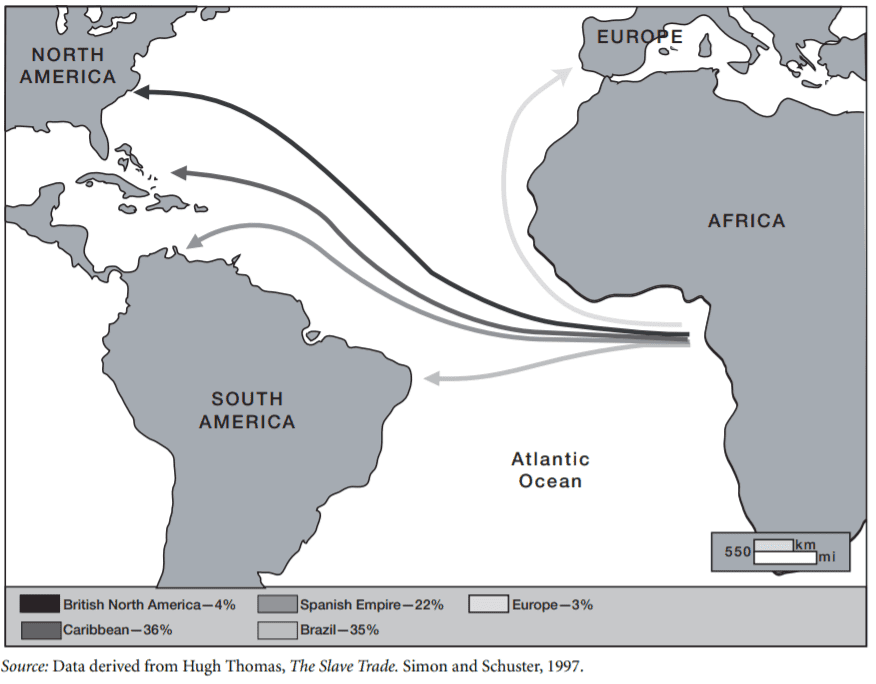
Question 17. According to the information given in the map, which of the following conclusions can be drawn?
A. The British colonies were the main destination of African slaves.
B. South America has a large population of African origin today.
C. The British colonies were the main destination of African slaves.
D. Most slaves were sent to work on sugar plantations in Brazil and in the Caribbean.✅
For questions 18-21, refer to the map provided below.
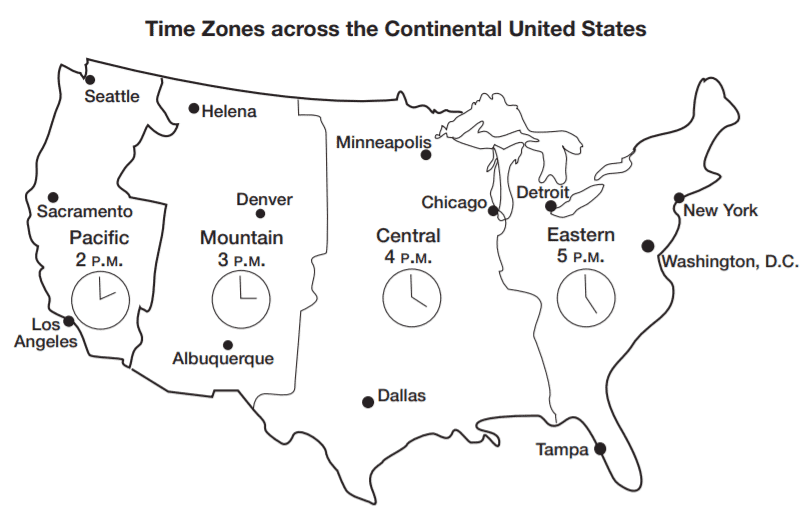
Question 18. According to the map, what time is it in Dallas when it is noon in Sacramento?
A. 2:00 A.M.
B. 1:00 A.M.
C. 3:00 P.M.
D. 2:00 P.M.✅
Question 19. What time is it in Sacramento, CA, when it is midnight in Tampa, FL?
A. 9:00 A.M.
B. 9:00 P.M✅
C.10:00 P.M.
D.1:00 A.M.
Question 20. As a traveler moves west, she can expect to
A. move into an earlier time zone for every 15 degrees of latitude she travels.✅
B. move into a later time zone for every 15 degrees of latitude she travels.
C. experience jet lag.
D. change time zones.
Question 21. In past presidential elections, television networks have made predictions about which candidate is likely to win before the polls closed throughout all of the nation’s time zones. Which of the following statements explains why this would anger some voters?
A. Voters in the Central time zone want to know who won in the eastern states.
B. Polls in the Pacific time zone open earlier if voters want their votes to be counted.
C. Predictions based on voting in eastern time zones influence those who have not yet voted in the more western time zones.✅
D. Polls close one hour later in the Mountain time zone than in the Central time zone.
For questions 22 and 23 refer to the excerpt provided below.
Beginning in 1958 . . . local NAACP [National Association for the Advancement of Colored People] chapters organized sit-ins, where African Americans, many of whom were college students, took seats and demanded service at segregated all-white lunch counters. It was, however, the sit-in demonstrations at Woolworth’s store in Greensboro, North Carolina, beginning on February 1, 1960, that caught national attention and sparked other sit-ins and demonstrations in the South. One of the four students in the first Greensboro sit-in, Joe McNeil, later recounted his experience: “ . . . we sat at a lunch counter where blacks never sat before. And people started to look at us. The help, many of whom were black, looked at us in disbelief too. They were concerned about our safety. We asked for service, and we were denied, and we expected to be denied. We asked why we couldn’t be served, and obviously, we weren’t given a reasonable answer, and it was our intent to sit there until they decided to serve us. Source: https://www.congresslink.org and Henry Hampton and Steve Fayer (eds.) Voices of Freedom: An Oral History of the Civil Rights Movement from the 1950s through the 1980s. Vintage Paperback, 1995.
Question 22. What is the author’s purpose in including Joe McNeil’s quotation?
A. to show that the college students had not intended to create a stir
B. to give a firsthand account of what has become a historic event✅
C. to discount the importance of the civil rights movement
D. to show that young people are the most likely to push for societal change
Question 23. Joe McNeil has not directly stated, but would support, which of the following statements?
A. Without the sit-in in Greensboro, NC, the civil rights movement would never have started.
B. Local NAACP chapters were causing trouble and upsetting citizens.
C. Nobody was surprised when black college students took a seat at the all-white lunch counter
D. The college students showed courage when they participated in the Greensboro sit-in.✅
For questions 24 and 25 refer to the passage provided below.
The U.S. Constitution does not explicitly give the power of judicial review to the Supreme Court. In fact, the court did not use this power—which gives it the authority to invalidate laws and executive actions if they conflict with the Constitution—until the 1803 case of Marbury v. Madison. In that case, Chief Justice John Marshall ruled that a statute was unconstitutional. He argued that judicial review was necessary if the court was to fulfill its duty of upholding the Constitution. Without it, he felt that the legislature would have a “real and practical omnipotence.” Moreover, several of the Constitution’s framers expected the court to act in this way. Alexander Hamilton and James Madison emphasized the importance of judicial review in the Federalist Papers, a series of essays promoting the adoption of the Constitution. However, the power of judicial review continues to be a controversial power because it allows the justices—who are appointed rather than elected—to overturn laws made by Congress and state lawmaking bodies
Question 24. Which of the following best describes the purpose of judicial review?
A. to declare a law unconstitutional✅
B. to adapt the Constitution to what the court feels is right
C. to propose new laws
D. to follow public opinion polls
Question 25. Which of the following statements is an implication of judicial review?
A. If Supreme Court justices were elected, the power of judicial review would be justified.
B. The Constitution is a historic document with little influence over how the government operates today
C. The Constitution is a living document that continues to be interpreted.✅
D. The Constitution must explicitly state which branch of government is to have what authority
Refer to the graph provided below and answer the question that follows.
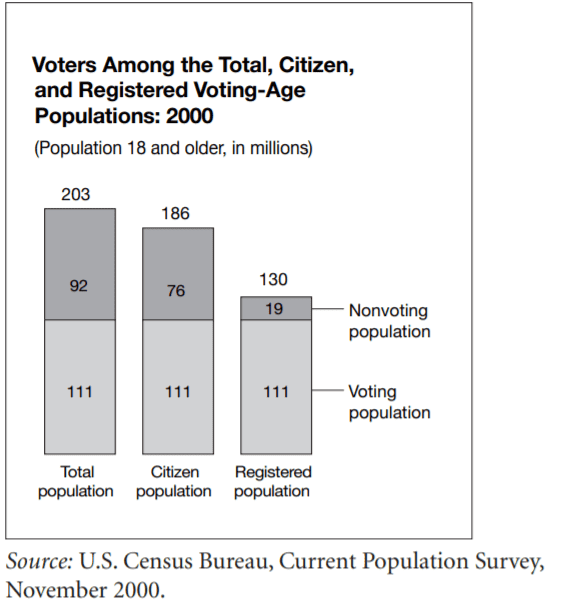
Question 26. According to the graph, how many eligible U.S. citizens are NOT registered to vote?
A. 92 million
B. 56 million✅
C. 130 million
D. 19 million
For questions 27 and 28 refer to the passage provided below.
Even though acid rain looks, feels, and even tastes like clean rainwater, it contains high levels of pollutants. Scientists believe car exhaust and smoke from factories and power plants are the main causes of acid rain, but natural sources like gases from forest fires and volcanoes may also contribute to the problem. Pollutants mix in the atmosphere to form fine particles that can be carried long distances by wind. Eventually, they return to the ground in the form of rain, snow, fog, or other precipitation. Acid rain damages trees and causes the acidification of lakes and streams, contaminating drinking water and damaging aquatic life. It erodes buildings, paint, and monuments. It can also affect human health. Although acid rain does not directly harm people, high levels of fine particles in acid rain are linked to an increased risk of asthma and bronchitis. Since the 1950s, the increase of acid rain has become a problem in the northeastern United States, Canada, and western Europe.
Question 27. Which of the following is NOT a cause of acid rain?
A. volcanoes
B. lakes and streams✅
C. human activity
D. natural phenomena
Question 28. Which of the following natural resources is least likely to be affected by acid rain?
A. coal reserves✅
B. forest
C. water
D. animal life
For questions 29-31, refer to the following graphs provided below.

Question 29. Which of the following statements is proved by the information in the two graphs?
A. The rate of population growth will reach an all-time low in 2050.
B. The rate of population growth will reach an all-time low in 2050.
C. Even though the rate of population growth is decreasing, the population is increasing.✅
D. The rate of population growth will reach an all-time low in 2050.
Question 30. The world population growth rate dropped one percentage point between the mid-1950s and 1960. Which of the following best explains this occurrence?
A. There were more deaths in 1960 than there were in the mid-1950s.
B. There were more births and fewer deaths in the mid-1950s than there were in 1960.✅
C. A baby boom in the decade after World War II caused a spike in the birth rate.
D. The introduction of the birth control pill in 1960 in the United States helped slow the birth rate
Question 31. The greatest increase in population growth rate between 1950 and 2000 occurred in
A. 1962–1963.✅
B. 1956–1957.
C. 1990–2000.
D. 2000–2001
For questions 32 and 33 refer to the quotation provided below.
“We might as easily reprove the east wind, or the frost, as a political party, whose members, for the most part, could give no account of their position, but stand for the defense of those interests in which they find themselves.” —Ralph Waldo Emerson (1803–1882), U.S. essayist
“A party of order or stability, and a party of progress or reform, are both necessary elements of a healthy state of political life.” —John Stuart Mill (1806–1873), British philosopher.
Question 32. Which of the following party systems would Mill most likely support?
A. one in which citizens are independent and think for themselves
B. one in which citizens are loyal to a political party at all costs
C. a two-party system
D. a system with a liberal party that advocates for change and a conservative party that maintains the tradition✅
Question 33. Which of the following party systems would Emerson most likely support?
A. one in which citizens are loyal to a political party at all costs
B. a multi-party system
C. one in which citizens are independent and think for themselves✅
D. a two-party system
For questions 34 and 35 refer to the following passage provided below.
The U.S. Constitution gives the president the power to veto, or reject, a bill passed by Congress. The president sends the proposed law back to Congress and states his objections. Because it takes a two-thirds vote from both the House of Representatives and the Senate to override a veto, Congress often changes the bill to make it more acceptable to the president. Sometimes, Congress adds provisions to a bill that the president strongly favors. The president does not have the power of line-item veto, in which lines or parts of a bill can be rejected individually. The president must accept or reject the bill as Congress has written it.
Question 34. Which of the following statements can you infer from the passage?
A. If a president vetoes a bill, there is no way to get it passed into law.
B. Congress tries to get the president to accept its provisions by attaching provisions to a bill that the president supports.✅
C. A president is more effective when members of the same political party are the majority in Congress.
D. Congress is more powerful than the president.
Question 35. Which of the following conclusions can you make based on the passage?
A. It is easier to rewrite and make a bill more acceptable to the president than it is to override a veto.✅
B. The U.S. Constitution gives the president the power to edit the bills he receives from Congress.
C. It is easier to override a veto than it is to rewrite and make a bill more acceptable to the president.
D. The system of checks and balances ensures that the president has no influence over the lawmaking branch of government.
